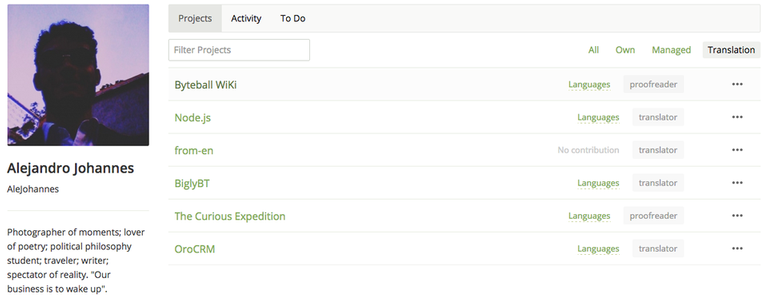Github Repository
https://github.com/nodejs/i18n
Project Details
By definition, Node.js is a Java Runtime Environment (JRE). But it is more than just that. While common JREs function as machine backups that allow users to smoothly run JavaScript on their browsers and applications, this open-source project functions as an app that manages Java code by itself. It's practical uses for developers are endless. It grants an extraordinarily versatile platform for designing code, programs, websites and other applications. And that isn't all: Node provides a virtual facility for testing the proper work of Java-driven programs and devices –and their planned updates–, helping to find bugs, solve errors, fix code and vastly improving their performance.
I believe all the amazing uses of Node are to be considered by themselves and I declare myself a fan of the project. But, besides, I support it for its functionality as a medium for bringing to reality countless creations that can be as good as Node itself. If you can dream it –and code it in JavaScript–, then your imagination is the only limit!The open translation of Node to thirty-three (33) languages proves the advantages of open-source projects when it comes to diversification of knowledge and worldwide spreading of useful tools.
Ahead, there is the link of the program's webpage:
Contribution Specifications
Translation Overview
This is my 30th contribution to Node.js as a translator. For this collaboration, I continued my previous work on the CHANGELOG_IOJS.md file, which –as its name indicates– contains the changelog of the io.js’ version of Node.
As I explained in my past translation reports, a changelog is a registry of all the changes made on determined project for each one of its versions. The files created for such purpose list modifications on internal components, substitutions of protocols, updates, deprecations, addition of supported tools, new functions, corrected errors and fixed bugs. In summary: every feature that first appeared or was removed in the program version being addressed must be specified and described in this registry. This is made with the purpose of providing a timeline of the development of the project and, by doing so, helping programmers to check any details they need to understand the way it came to be what it is and improve it in the future.
I'll refer two of the logs I translated to illustrate the dynamics of the changelog. Both of them are included in the "Commits" section of the addressed file's stable version 1.7.0. The first one goes:
There are two important concepts involved in this log and, before we can understand it, we need to address them individually.
The first one is "fast math". Fast math is the common name for the set of functions, built in this case for JavaScript, that allow users to perform mathematical operations in a more quickly way than the regular ones, so the processes that depend on them can be conducted smoothly, saving time to said users. Currently, there are whole packages of JavaScript coding designed by advocate developers with the intention of providing alternative functions that realize the same operations the originals do, but faster. Summarizing, a fast math function would look something like this:
While regular math functions are regarded by some users as something like:
The second one is "arm". ARM is a family of CPU processors designed to be smaller in size and more efficient in performance than other groups of their kind. The glittery of these is that they have a ridiculously enormous capacity to perform tons of operations at the same time while not reducing the speed of the whole system. This is why they are top-choice for mobile devices, whose operating systems require multi-tasking instruments that occupy little space.
Knowing these facts, we understand that the aforementioned commit seeks to increase the performance of the machine by prohibiting the use of fast math functions: they might not be as efficient as they are intended to be with ARM processors as with the regular ones, since the facilities of said processors supports the conduction of common functions in a better way.
The second log I'll refer is this one:
Just one comment on this one. What does "readonly" means in programming? It means just that: that the users who want to access to certain data identified with that level of permission will only be allowed to read it, not modify it, as a write permission would. Readonly means... "Read only"... Clever... I know. That being so, read-only data can bee seen as textbooks, while files with write permission can be seen as notebooks. In this commit, developers want to make the zlib constants, that are notebook-alike, to be textbooks, so they do not depend on the will of users and don't get all messed up because of them.
You can check some references here for more information about the previously addressed concepts:
- https://www.gamedev.net/forums/topic/583470-c-slowfast-math-functions/
- https://www.element84.com/blog/improving-java-math-performance-with-jafama
- https://whatis.techtarget.com/definition/ARM-processor
- https://www.pantechsolutions.net/programming-with-arm-processors
- https://en.wikipedia.org/wiki/ARM_architecture
- https://docs.microsoft.com/en-us/dotnet/csharp/language-reference/keywords/readonly
- https://www.techopedia.com/definition/856/read-only
- https://www.webopedia.com/TERM/R/read_only.html
All changes included in each one of the versions of the project are formatted as pull-request commits. Id est, they are presented as very brief comments about the action that was suggested, are normally written with imperative verbs, and have a strict limitation on their number of characters (so even complex ideas are reduced to a small amount of words). These specifications made the translation of this document a challenge. However, it was satisfactorily achieved. As you will see in the examples below, the name of the developer who provided each log is often referred inside parenthesis at the end of it.
Work example #01:
English:
[<0>1514b82355</0>] - <1>(SEMVER-MINOR) src</1>: add -r/--require flags for preloading modules (Ali Ijaz Sheikh) <2>#881</2>
Spanish:
[<0>1514b82355</0>] - <1>(SEMVER-MINOR) src</1>: añadir las banderas -r/--require para los módulos de pre-carga (Ali Ijaz Sheikh) <2>#881</2>
Work example #02:
English:
[<0>68d4bed2fd</0>] - <1>make</1>: remove node_dtrace from cpplint excludes (Julien Gilli) <2>joyent/node#8741</2>
Spanish:
[<0>68d4bed2fd</0>] - <1>make</1>: remover node_dtrace de las exclusiones de cpplint (Julien Gilli) <2>joyent/node#8741</2>
Work example #03:
English:
Pending data was not being fully read upon an <0>'error'</0> event leading to an assertion failure on <0>socket.destroy()</0>.
Spanish:
Los datos pendientes no estaban siendo leídos completamente cuando se producía un evento de <0>'error'</0> que conducía a una falla de aserción ante <0>socket.destroy()</0>.
Languages
This translation was made from English to Spanish.
I got plenty experience translating and proofreading this project as an Utopian contributor. I collaborate here as translator and Language Moderator of the Da-Vinci/Utopian Spanish translation team. Besides this project, I have experience translating and proofreading The Curious Expedition, Ancap-ch, Byteball Wiki, OroCrm and BiglyBT.
Word Count
- The amount of words translated in this contribution is: 2,045.
- The total amount of words translated in this project (as a Da-vinci/Utopian translator) is: 38,455.
Previous Translations of the Project
- Contribution N'01. Submitted on September 13th, 2018.
- Contribution N'02. Submitted on September 15th, 2018.
- Contribution N'03. Submitted on September 17th, 2018.
- Contribution N'04. Submitted on September 19th, 2018.
- Contribution N'05. Submitted on September 21th, 2018.
- Contribution N'06. Submitted on September 22th, 2018.
- Contribution N'07. Submitted on September 23th, 2018.
- Contribution N'08. Submitted on October 1st, 2018.
- Contribution N'09. Submitted on October 8th, 2018.
- Contribution N'10. Submitted on October 14th, 2018.
- Contribution N'11. Submitted on October 15th, 2018.
- Contribution N'12. Submitted on October 18th, 2018.
- Contribution N'13. Submitted on October 21st, 2018.
- Contribution N'14. Submitted on October 24th, 2018.
- Contribution N'15. Submitted on October 27th, 2018.
- Contribution N'16. Submitted on October 31th, 2018.
- Contribution N'17. Submitted on November 3rd, 2018.
- Contribution N'18. Submitted on November 4th, 2018.
- Contribution N'19. Submitted on November 6th, 2018.
- Contribution N'20. Submitted on November 17th, 2018.
- Contribution N'21. Submitted on November 24th, 2018.
- Contribution N'22. Submitted on December 7th, 2018.
- Contribution N'23. Submitted on December 15th, 2018.
- Contribution N'24. Submitted on December 20th, 2018.
- Contribution N'25. Submitted on December 26th, 2018.
- Contribution N'26. Submitted on December 28th, 2018.
- Contribution N'27. Submitted on December 30th, 2018.
- Contribution N'28. Submitted on January 9th, 2018.
- Contribution N'29. Submitted on January 10th, 2018.
Proof of Authorship
This translation was made January 11th. You can check the translation record in my Crowdin account [here], the activity on the project's Crowdin [here] and a summary of recent additions to the project [here].









Hi @alejohannes,
Thank you for submitting a new contribution!
Node.js is a very interesting project that contains many code values and terms related to computer science. Its difficulty relies on the fact that we must pay a lot of attention to the code in order to deliver the most accurate translation possible.
Your presentation post is not only informative but also fun to read, it is well written and formatted. It also includes all the basic details, as well as your personal feedback. You shared clear and precise concepts you learned while working on this contribution in a very dynamic way.
Once again, you delivered an accurate translation. You used the correct vocabulary and you were careful with code values that should not be translated in order to make sure the text keeps its true meaning.
I'm looking forward to your next contribution.
Your contribution has been evaluated according to Utopian policies and guidelines, as well as a predefined set of questions pertaining to the category.
To view those questions and the relevant answers related to your post, click here.
Chat with us on Discord
Thank you for your review, @marugy99! Keep up the good work!
Congratulations @alejohannes! You have completed the following achievement on the Steem blockchain and have been rewarded with new badge(s) :
Click here to view your Board
If you no longer want to receive notifications, reply to this comment with the word
STOPTo support your work, I also upvoted your post!
Do not miss the last post from @steemitboard:
Hi @alejohannes!
Your post was upvoted by @steem-ua, new Steem dApp, using UserAuthority for algorithmic post curation!
Your post is eligible for our upvote, thanks to our collaboration with @utopian-io!
Feel free to join our @steem-ua Discord server
Hey, @alejohannes!
Thanks for contributing on Utopian.
We’re already looking forward to your next contribution!
Get higher incentives and support Utopian.io!
Simply set @utopian.pay as a 5% (or higher) payout beneficiary on your contribution post (via SteemPlus or Steeditor).
Want to chat? Join us on Discord https://discord.gg/h52nFrV.
Vote for Utopian Witness!